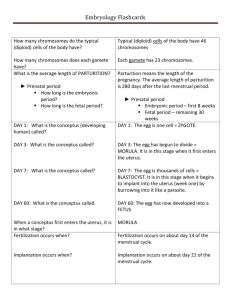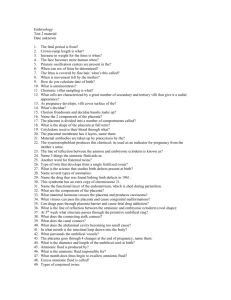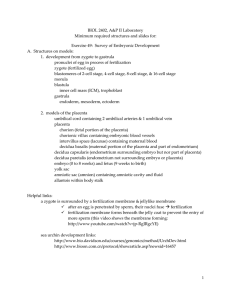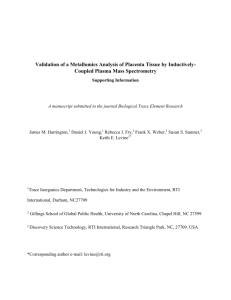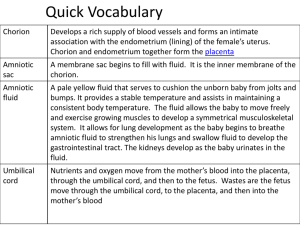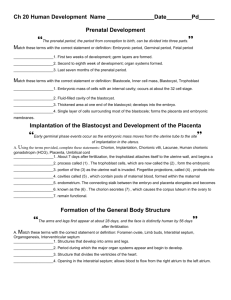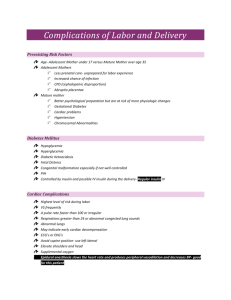The placenta, Membranes , and umbilical cord
advertisement
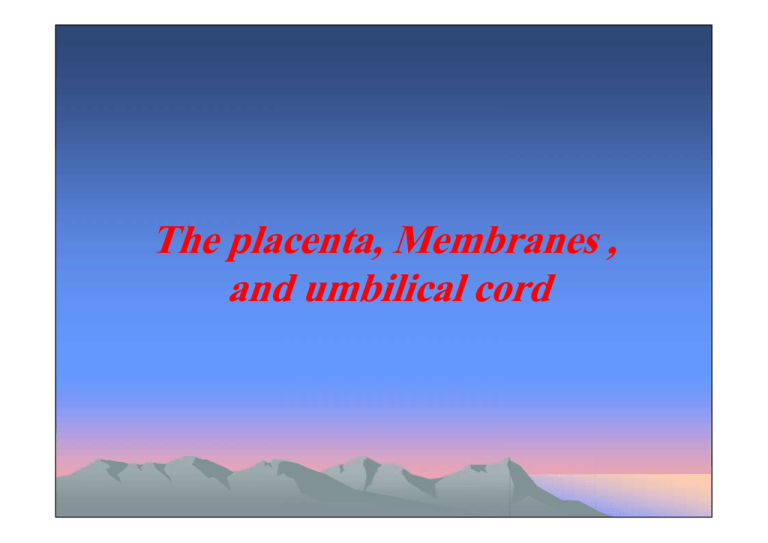
The placenta, Membranes , and umbilical cord Development of the placenta is a highly regulated process that is essential for normal fetal growth and development, and for maintenance of a healthy pregnancy. The placenta fulfills several critical roles as it preventing rejection of the fetal allograft; transporting and metabolizing nutrients, and providing peptide and steroid hormones. Developmental Anatomy And Structure • Development of the placenta and fetus is a continuous process that begins at the time of fertilization. The morula enter the uterine cavity 4days after Fertilization and fluid filled space single cavity is formed and the embryo known as blastocyst The cells of the inner cell mass known as embryoblast are located at one pole while of the outer cell known as trophoblast, flattened to form the epithelial wall of blastocyst. The morula enter the uterine cavity 4days after Fertilization and fluid filled space single cavity is formed and the embryo known as blastocyst The cells of the inner cell mass known as embryoblast are located at one pole while of the outer cell known as trophoblast, flattened to form the epithelial wall of blastocyst. INTRODUCTION The blastocyst is bathed in uterine secretions that provide the embryo with oxygen and metabolic substrates. However, this soon becomes inadequate for further development, and the embryo must then implant in the uterine wall. At the beginning of the 2nd week , the blastocyst is partially embedded in the endometrial stroma . The trophoblast differentiates into : 1- An inner ,actively proliferating layer ,the cytotrophoblast. 2-An outer layer,the syncytiotrophoblast By day 9 lacuna develop in syncytiotrophoblast. Sebsequently,maternal sinusoid are eroded by the syncytiosyncytio- trophoblast maternal blood enters the lacunar network, and by the end of the 2nd week, a primitive uteroplacental circulation begins. The progenitor villous trophoblast cell is the stem cell of the placenta. It proliferates throughout gestation, differentiating along two pathways to invasive extravillous trophoblast (EVT) and the syncytiotrophoblast ,as show in following figure. ﺑﺴـﻢ ﺍ ﺍﻟﺮﲪﻦ ﺍﻟﺮﺣﻴـﻢ ﴿ ﻳﺮﻓـﻊ ﺍﻟﻠــﻪ ﺍﻟﺬﻳﻦ ﺁﻣﻨـﻮﺍ ﻣﻨﻜــﻢ ﻭﺍﻟﺬﻳﻦ ﺃﻭﺗﻮﺍ ﺍﻟﻌﻠــﻢ ﺩﺭﺟﺎﺕ ﻭﺍﻟﻠـﻪ ﲟﺎ ﺗﻌﻤﻠﻮﻥ ﺧﺒﲑ﴾ ﺻـﺪﻕ ﺍ ﺍﻟﻌﻈﻴـﻢ )ﺍﺎﺩﻟـﺔ( ٢٨ The extra villous trophoblast ( EVT ) is responsible for invasion, thereby anchoring the placenta to the decidua and myometrium. The syncytiotrophoblast is a specialized epithelium covering the villous tree and has several functions, such as transport of gases, nutrients, and waste products and synthesis of peptide and steroid hormones that regulate placental, fetal, and maternal systems. Alterations in villous trophoblast differentiation are seen in various pathophysiological situations and may underlie several pregnancy disorders. Endovascular EVTs are associated with spiral arteries, either within the vessel wall (intramural) or replacing endothelium (intra--arterial). EVTs transform the narrow (intra spiral arteries to wide uteroplacental arteries, which distribute blood into a low resistance vascular network . Defects in EVT invasion occur with preeclampsia and intrauterine growth restriction (IUGR), where some spiral arteries are not invaded at all and some are superficially invaded, leading to lack of the normal physiological adaptation of spiral arteries to pregnancy, reduced blood flow into the intervillous space, and relative hypoxia/ischemia. VASCULATURE The proportion of the placenta occupied by blood vessels increases throughout gestation to facilitate nutrient transport. The two umbilical arteries and the vein divide into networks of secondary vessels, and then further divide into tertiary vessels before penetrating the chorionic plate and entering the main stem villi. These then divide two to five times to form rami chorii (intermediate villi) and further divide to form ramuli chorii, some of which terminate in the terminal villi, the functional units of exchange as shown in following figure. The terminal villi each contain up to 10 capillaries which form capillary loops and occasional sinusoids, perhaps to reduce resistance and slow blood flow in order to maximize time for gas and nutrient exchange. Structure of placenta By the beginning of the 4th month , the placenta has 2 components: 1- A fetal portion: formed by chorion frondosum ( the villli on embryonic pole , continue to grow and expand ,thus giving rise to chorion frondosum;bushy chorion). 2-A maternal portion :formed by decidua basalis. On the fetal side ,the placenta is bordered by the chorionic plate; on its maternal side,it is bordered by the decidua basalis,of which the decidual plate is intimatly incorporated into the placenta. Between the chorionic and decidual plates are the intervillous spaces that are filled with maternal blood. During the 4th and 5th months ,the decidua forms anumber of septa,the decidual septa,which project into the intervillous space but do not reach the chorionic plate. As a result of this septum formation,the placenta is divided into a number of compartments which are called cotyledons cotyledons.Since .Since the decidual septa do not reach the chorionic plate ,contact between the intervillous spaces in the various cotyledons is maintained. As a result of fetus growth and uterus expantion ,the placenta also enlarged.Its increase in surface area roughly parallels that of the expanding uterus. And through pregnancy it covers approximately 15 15--30 ٪ of the internal surface of the uterus. Full term placenta: At full term ,the placenta has a discoid shape , adiameter of 15 15--25 cm cm,, is approximately 3 cm thick, and has a weight of about 500 500--600 gm gm.. At birth , it is torn from the uterine wall and , approximately 30 minutes after birth of the child , is expelled from the uterine cavity. When, after birth , the placenta is viewed from the maternal side ,15 ,15 -20 cotyledons covered by a thin layer of decidua basalis are clearly recognizable. The fetal surface of the placenta is covered entirely by the chorionic plate. A number of large arteries and veins (the chorionic vessels )converge )converge toward the umbilical cord . The chorion in turn covered by the amnion. Attachment of the umbilical cord is usually eccentric and occasionally even marginal . Rarely however , does it insert into the chorionic membranes outside the placenta (velamentous insertion ). Circulation of placenta Cotyledon receive their blood through 80 80--100 spiral arteries that pierce the decidual plate and enter the intervillous space at more or less regullar intervals . The lumen of spiral artery is narrow ,resulting in an increased blood pressure when enter the intervillous space. This pressure forces the blood deep into the intervillous spaces and bathes numerous small villi of villous tree in oxygenated blood. As the pressure decreases blood flows back from chorionic plate toward the decidua.,then to maternal circulation throuh endometrial veins. Since the maternal blood in the intervillous space is separated from fetal blood by a chorionic derivative, the human placenta is consider to be of hemochorial type. Function of placenta 1- Prevention of the fetal allograft rejection. 2-Metabolic functions:functions:In addition to gas and nutrient exchange, the placenta is capable of synthesizing glycogen and cholesterol, which are energy sources to the developing fetus. Additionally, cholesterol is an important precursor for hormone production by the fetofeto-placental unit, also has a rule in protein metabolism and lactate removal. 3-Anticoagulant activity : Thrombosis in the placental vasculature can result in pregnancy loss . To prevent stasis and coagulation of blood in the low velocity intervillous space, the trophoblast actively secretes substances (nitric oxide and carbon monoxide) that prevent platelet and leukocyte adhesion and aggregation to the trophoblast surface . The trophoblast surface also has anticoagulant activity. 4-Endocrine function:function:- The placenta is not innervated, hence any communication between it, the mother, and the fetus must involve humoral agents. The signaling molecules secreted by the placenta can act locally through paracrine and autocrine regulation. The placenta also acts as an important endocrine organ and is responsible for the release of hormones into both the fetal and maternal circulation. The hormones produced by the placenta can be split into two categories: A- Peptide hormones : human chorionic gonadotrophin (hCG), human placental lactogen (hPL), cytokines, growth hormone (GH), insulininsulin-like growth factors (IGF's), corticotropin releasing hormone (CRH), placental growth factor (PIGF) B-Steroid hormones : estrogens, progesterone and glucocorticoids 5-Imprenting genes:- Imprinting refers to the differential expression of genetic material depending on whether it was inherited from the male or female parent. PLACENTAL TRANSFER The syncytiotrophoblast layer of the placenta is the main site of exchange for nutrients and gases between the maternal blood stream and the fetus. The efficient transfer of nutrients and solutes across the placenta is essential for normal fetal growth and development. Mechanisms ::- There are several mechanisms by which transfer occurs: 1- Solvent drag : Solvent drag is the movement (bulk flow) of water in which solutes and nutrients are dissolved. Bulk flow has been demonstrated in the perfused human placental cotyledon in response to hydrostatic pressure changes . 2-Simple diffusion: Simple diffusion is the passive transfer of solutes driven by concentration and electrical gradients. All solutes are transferred by diffusion, but the relative contribution is dependent on molecular properties. As an example, lipophilic molecules, such as respiratory gases, are readily exchanged by simple diffusion 3-Transcellular transfer: There are three types: * Channels . * Facilitated diffusion . * Carrier mediated active transport 4- Endocytosis and exocytosis: During endocytosis, material is engulfed in a sample of extracellular fluid following invagination of the cell surface to form a fluid filled vesicle. Exocytosis is the reverse of this process, where vesicles fuse with the cell membrane to release their contents. This process can be receptor mediated, that is, it is triggered by a specific interaction between the solute and a receptor on the cell membrane. Transfer of specific substances Respiratory gas exchange ::- Both oxygen and - carbon dioxide are lipophilic molecules which will cross the placenta by simple diffusion. Glucose transport ::- By facilitated diffusion Amino acid transport ::-By active transport. Fatty acid transport ::-Fats are transport by simple difusion. Immunoglobulin G transfer ::- Maternal antibodies are readily transported across the placenta to confer immunity to the fetus. From early in the second trimester the concentration of Immunoglobulin G (IgG) in fetal blood increases , with most antibodies being acquired in the third trimester. IgG is transported across the syncytiotrophoblast via the Fc receptors (pinocytosis). Drugs ::- Most drugs cross the placenta by simple diffusion. Factors that affect transfer include molecular weight, degree of ionization, lipid solubility, protein binding, and fetal and placental blood flow. Nonionized, nonprotein bound, lipid soluble drugs with molecular weight below 600 Daltons freely cross the placenta Membranes Membranes The placental membranes are composed of two layers; the layer nearest the fetus (facing the amniotic cavity) is the amnion,, the layer immediately beyond it amnion is the chorion. The amnion is a membranous tissue with an epithelial layer made up of short cuboidal cells and a mesenchymal layer consisting of minimally cellular fibrous tissue. The chorion has an upper layer of minimally cellular fibrous tissue and, more importantly, an epithelial cellular layer composed of trophoblast cells adjacent to the decidua. The trophoblast cells of the chorion are derived from the trophoblast cells which form the entire epithelial lining of the placenta. They are the cells that communicate with the maternal blood, anchor the placenta, and provide the hormones that support the pregnancy. Umbilical cord The umbilical cord connects the body of the fetus with the placenta. It is normally composed of two umbilical arteries and an umbilical vein supported by loose gelatinous tissue called Wharton's Jelly. Jelly. The cord increases in length as the fetus grows and it has a characteristic twist or coil . The average length is 55 cm cm,, with a wide range typically considered normal (ie. 35 to 80 cm)
